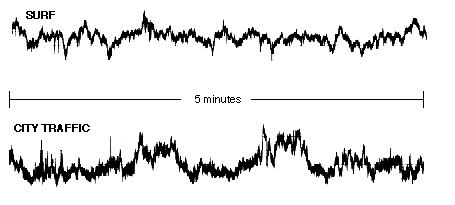A sound or SOUND OBJECT whose AMPLITUDE is relatively unchanging. However, in any natural sound the SPECTRUM is always changing (see diagram under FOURIER ANALYSIS) and there are usually slight fluctuations in amplitude even in what appears to be a steady sound.
Mechanical or electrical sounds (e.g. HUMs) are usually examples of stationary sound that are almost completely unchanging. They may be called flatline sounds or DRONEs because of their steadiness.
Compare: ENVELOPE, GRAIN, INTERNAL DYNAMICS, REDUNDANCY, STANDING WAVES, STATIONARY STATE, TAPE LOOP, TEMPO, TRANSIENT.
Many similar sound sources, or a single sound source with many components, will combine to produce an aggregate texture that may be called quasi-stationary or quasi-continuous sound. The individual ATTACK and DECAY of the separate components cannot be distinguished, except as fluctuations of the continuous texture. Distant surf and traffic are examples of this type of sound, as shown in the level recordings below.
Compare: AMBIENCE, STOCHASTIC PROCESS.

ENVELOPEs of quasi-stationary complex sounds.
![]() Sound
Example: Surf, along the Newfoundland
coast.
Sound
Example: Surf, along the Newfoundland
coast.
Sound Example: City traffic, Ottawa, Ontario.
home